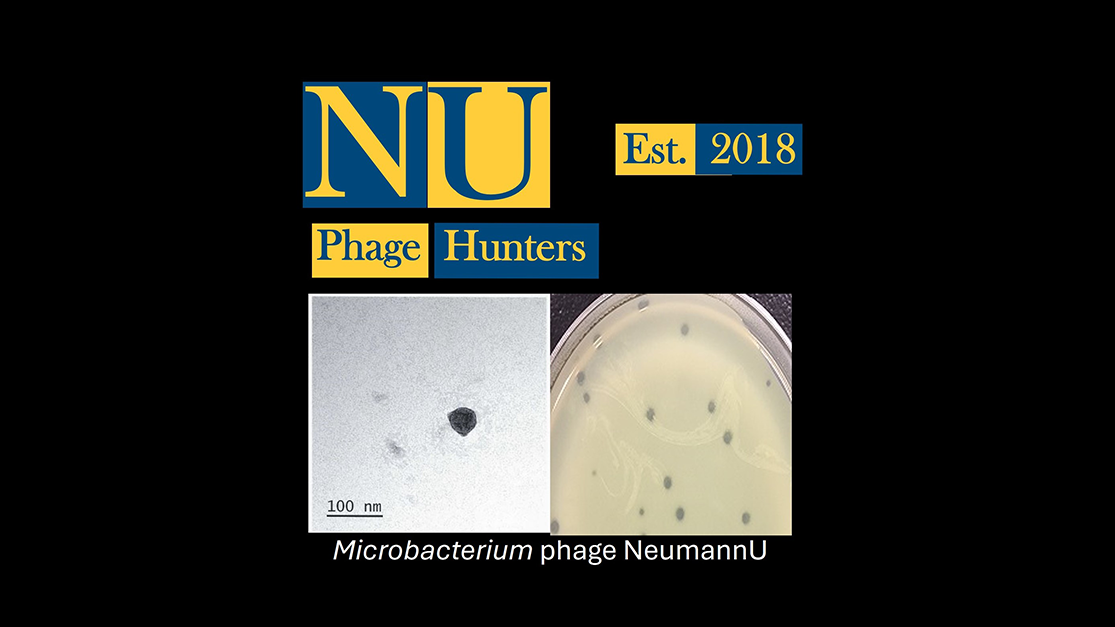
During the last seven years, more than 40 students in Dr. Matthew Mastropaolo’s biology classes – as well as some faculty and staff -- have discovered 40 previously unidentified phages. They all hope that their discoveries are never used.
Phages are viruses that attack bacteria. As Mastropaolo explains it, “The phage is the predator, the bacterium is the prey.”
The process is unsettling. According to Mastropaolo, the phage combines with the host (bacterium) and injects its genetic material into the host, creating a next-generation phage. The new phage then “chews” its way out by dissolving the cell so that the cell explodes.
If this image reminds you of the creature from the movie Alien, you’re not alone. One book about phages is titled The Perfect Predator, a clear reference to the 1979 science fiction film.
Over the last two years, 39 of the students (many of whom are now alumni) have been authors in two issues of Microbiology Resource Announcements, a peer-reviewed journal that included 12 discoveries isolated and annotated by the students.
The medical application is that phages can be used to treat patients with bacterial infections that are resistant to multiple antibiotics.
Sounds helpful, right? Here’s the catch. “Based on U.S. governmental guidelines,” says Mastropaolo, “phages are only approved for compassionate use, when all other treatment fails.”
No student would want patients to be in such dire condition that they qualify for compassionate use. Sadly, though, a very small number of patients confront the reality that no other treatment is available.
According to Mastropaolo, “The purpose of collecting phage information is to build a database of its genetics.” This database is used to catalog the phages into groups. The Hatfull Lab at the University of Pittsburgh stores all of the phages for later use. In order to identify phages that can be used, experiments have to be performed using antibiotic-resistant strains from the patient.
The educational benefit, of course, is that students learn scientific research first-hand, isolating and identifying previously unknown phages – most of them found in the soil on campus. Working in groups, the students identified dozens of new phages.
An added kick for students is that they get to name the phages that they discover. They have dubbed their discoveries Swervy, Fullmetal, Stormbreaker, Eightball, and a host of other quirky names, many with origins in pop culture. The permission to name the phage, notes Mastropaolo, is an incentive to promote project ownership.
The students had their research published by Microbiology Resource Announcements (MRA) during a two-year period. In March of this year, 24 students were cited: Oluwatomiwah Adebamiro, Ameera Alade, Hannah Asaka, Wilfred Bangura, Keyshla Valentin Caban, Sydney Cahill, Davia Campbell, Keara Dougherty, Kaitlyn Green, Star Hargraves, Tommy Jiminez, Elizabeth Kalesnik, Melissa Logue, Christopher Negro, Casandra Nguyen, Esther Ogunyinka, Jonathan Onimus, Milan Peele, Hannah Radziak, Ulises Nunez Rodriguez, Cecelia Schmeltzer, Daekwon Sequira, Christina Shimp, and Luke Willette.
In April of 2023, MRA acknowledged 15 students: Campbell, Negro and Sequira (above) as well as Megan Bates, Christian Bjorkelo, Colleen Collins, Nicholas Crowley, Victoria Dower, Hailey Johnson, Thomas Mansbridge, Amanda Metzler, Emily Sasher, Ian Sigmund-Hamre, Kho Tuang, and Courtney Womack.
Future biology students still have plenty of work to do. Mastropaolo admits that an expert in the field has estimated the number of phages at 1031.
 CHALLENGE
CHALLENGE






